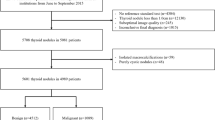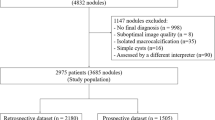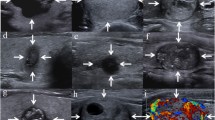Abstract
Objectives
The ultrasound (US) lexicon of nodule echogenicity and echotexture is one of the major differences among various risk stratification systems of thyroid nodules. This study aimed to stratify the US malignancy risk of thyroid nodules based on their degree of hypoechogenicity and echotexture.
Material and methods
This retrospective study included a total of 2255 consecutive thyroid nodules (≥ 1 cm) with final diagnoses (malignancy rate, 13%) from 2011 to 2016. Thyroid nodules were stratified according to the US degree of hypoechogenicity (mild, moderate, or marked hypoechogenicity) and echotexture (homogeneous vs. heterogeneous). The calculated malignancy risk was compared between each category.
Results
There was no significant difference of malignancy risk between the homogeneous markedly hypoechoic and moderately hypoechoic nodules (p ≥ .18). However, the malignancy risks of markedly and moderately hypoechoic nodules were significantly higher than those of mildly hypoechoic nodules (p < .001). Heterogeneous predominantly hypoechoic thyroid nodules showed a significantly higher malignancy risk than predominantly iso- or hyperechoic thyroid nodules (p < .001). There were no significant differences of malignancy risk between heterogeneous predominantly hypoechoic and homogeneous hypoechoic nodules according to the degree of hypoechogenicity (p ≥ .12) and between heterogeneous predominantly iso- or hyperechoic nodules and homogeneous iso- or hyperechoic thyroid nodules (p = .36).
Conclusions
The malignancy risk of nodule hypoechogenicity is stratified as mild vs. moderate to marked hypoechogenicity, and the malignancy risk of nodules with heterogeneous echotexture is stratified by the predominant echogenicity of the nodules.
Key Points
• Thyroid nodule echogenicity is categorized as marked, moderate, or mild hypoechogenicity and iso- or hyperechogenicity with the reference standard of adjacent thyroid tissue and anterior neck muscles.
• The malignancy risk of thyroid nodule echogenicity is stratified as iso- or hyperechoic vs. mild vs. moderate or marked hypoechogenicity.
• The malignancy risk of nodules with heterogeneous echotexture is stratified by the predominant echogenicity.



Similar content being viewed by others
Abbreviations
- ACR:
-
American College of Radiology
- ETA:
-
European Thyroid Association
- FNA:
-
Fine needle aspiration
- KSThR:
-
Korean Society of Thyroid Radiology
- PTC:
-
Papillary thyroid carcinoma
- SCM:
-
Sternocleidomastoid muscles
- US:
-
Ultrasonography
References
Moon WJ, Jung SL, Lee JH et al (2008) Benign and malignant thyroid nodules: US differentiation--multicenter retrospective study. Radiology 247:762–770
Campanella P, Ianni F, Rota CA, Corsello SM, Pontecorvi A (2014) Quantification of cancer risk of each clinical and ultrasonographic suspicious feature of thyroid nodules: a systematic review and meta-analysis. Eur J Endocrinol 170:R203–R211
Brito JP, Gionfriddo MR, Al Nofal A et al (2014) The accuracy of thyroid nodule ultrasound to predict thyroid cancer: systematic review and meta-analysis. J Clin Endocrinol Metab 99:1253–1263
Remonti LR, Kramer CK, Leitao CB, Pinto LC, Gross JL (2015) Thyroid ultrasound features and risk of carcinoma: a systematic review and meta-analysis of observational studies. Thyroid 25:538–550
Na DG, Baek JH, Sung JY et al (2016) Thyroid imaging reporting and data system risk stratification of thyroid nodules: categorization based on solidity and echogenicity. Thyroid 26:562–572
Kim EK, Park CS, Chung WY et al (2002) New sonographic criteria for recommending fine-needle aspiration biopsy of nonpalpable solid nodules of the thyroid. AJR Am J Roentgenol 178:687–691
Haugen BR, Alexander EK, Bible KC et al (2016) 2015 American Thyroid Association management guidelines for adult patients with thyroid nodules and differentiated thyroid cancer: the American Thyroid Association Guidelines Task Force on Thyroid Nodules and Differentiated Thyroid Cancer. Thyroid 26:1–133
Shin JH, Baek JH, Chung J et al (2016) Ultrasonography diagnosis and imaging-based management of thyroid nodules: revised Korean Society of Thyroid Radiology consensus statement and recommendations. Korean J Radiol 17:370–395
Gharib H, Papini E, Garber JR et al (2016) American Association of Clinical Endocrinologists, American College Of Endocrinology, and Associazione Medici Endocrinologi Medical guidelines for clinical practice for the diagnosis and management of thyroid nodules – 2016 update. Endocr Pract 22:622–639
Russ G, Bonnema SJ, Erdogan MF, Durante C, Ngu R, Leenhardt L (2017) European Thyroid Association guidelines for ultrasound malignancy risk stratification of thyroid nodules in adults: the EU-TIRADS. Eur Thyroid J 6:225–237
Tessler FN, Middleton WD, Grant EG et al (2017) ACR Thyroid Imaging, Reporting and Data System (TI-RADS): white paper of the ACR TI-RADS Committee. J Am Coll Radiol 14:587–595
Kim JH, Na DG, Lee H (2018) Ultrasonographic echogenicity and histopathologic correlation of thyroid nodules in core needle biopsy specimens. Korean J Radiol 19:673–681
Hong MJ, Na DG, Baek JH, Sung JY, Kim JH (2017) Cytology-ultrasonography risk-stratification scoring system based on fine-needle aspiration cytology and the Korean-Thyroid Imaging Reporting and Data System. Thyroid 27:953–959
Landis JR, Koch GG (1977) The measurement of observer agreement for categorical data. Biometrics 33:159–174
Ha EJ, Baek JH, Lee JH et al (2015) A focal marked hypoechogenicity within an isoechoic thyroid nodule: is it a focal malignancy or not? Acta Radiologica 56:814–819
Lee HY, Baek JH, Ha EJ et al (2016) Malignant-looking thyroid nodules with size reduction: core needle biopsy results. Ultrasonography 35:327–334
Delfim RLC, Veiga LCGD, Vidal APA, Lopes FPPL, Vaisman M, Teixeira PFDS (2017) Likelihood of malignancy in thyroid nodules according to a proposed Thyroid Imaging Reporting and Data System (TI-RADS) classification merging suspicious and benign ultrasound features. Arch Endocrinol Metab 61:211–221
Wu MH, Chen CN, Chen KY et al (2016) Quantitative analysis of echogenicity for patients with thyroid nodules. Sci Rep 6:35632
Isarangkul W (1993) Dense fibrosis. Another diagnostic criterion for papillary thyroid carcinoma. Arch Pathol Lab Med 117:645–646
Chen SJ, Yu SN, Tzeng JE et al (2009) Characterization of the major histopathological components of thyroid nodules using sonographic textural features for clinical diagnosis and management. Ultrasound Med Biol 35:201–208
Persichetti A, Di Stasio E, Guglielmi R et al (2018) Predictive value of malignancy of thyroid nodule ultrasound classification systems: a prospective study. J Clin Endocrinol Metab 103:1359–1368
Grani G, Lamartina L, Cantisani V, Maranghi M, Lucia P, Durante C (2018) Interobserver agreement of various thyroid imaging reporting and data systems. Endocr Connect 7:1–7
Hoang JK, Middleton WD, Farjat AE et al (2018) Interobserver variability of sonographic features used in the American College of Radiology Thyroid Imaging Reporting and Data System. AJR Am J Roentgenol 211:162–167
Itani M, Assaker R, Moshiri M, Dubinsky TJ, Dighe MK (2019) Inter-observer variability in the American College of Radiology Thyroid Imaging Reporting and Data System: in-depth analysis and areas for improvement. Ultrasound Med Biol 45:461–470
Song YS, Kim JH, Na DG et al (2016) Ultrasonographic differentiation between nodular hyperplasia and neoplastic follicular-patterned lesions of the thyroid gland. Ultrasound Med Biol 42:1816–1824
Ng SC, Kuo SF, Hua CC et al (2018) Differentiation of the follicular variant of papillary thyroid carcinoma from classic papillary thyroid carcinoma: an ultrasound analysis and complement to fine-needle aspiration cytology. J Ultrasound Med 37:667–674
Funding
This research was supported by the Medical Research Promotion Program through the Gangneung Asan Hospital funded by the Asan Foundation (2018-C03).
Author information
Authors and Affiliations
Corresponding author
Ethics declarations
Guarantor
The scientific guarantor of this publication is Dong Gyu Na.
Conflict of interest
The authors declare that they have no competing interests.
Statistics and biometry
No complex statistical methods were necessary for this paper.
Informed consent
Written informed consent was waived by the institutional review board.
Ethical approval
Institutional review board approval was obtained.
Methodology
• Retrospective
• Cross-sectional study
• Performed at one institution
Additional information
Publisher’s note
Springer Nature remains neutral with regard to jurisdictional claims in published maps and institutional affiliations.
Electronic supplementary materials
ESM 1
Supplementary Table 1. Malignancy risk stratified by degree of hypoechogenicity and echotexture, after excluding nodules with single benign FNA result and high suspicion US feature (n = 2176). Supplementary Table 2. Malignancy risk stratified by degree of hypoechogenicity and echotexture (Reader 2). (DOCX 27 kb)
Rights and permissions
About this article
Cite this article
Lee, J.Y., Na, D.G., Yoon, S.J. et al. Ultrasound malignancy risk stratification of thyroid nodules based on the degree of hypoechogenicity and echotexture. Eur Radiol 30, 1653–1663 (2020). https://doi.org/10.1007/s00330-019-06527-8
Received:
Revised:
Accepted:
Published:
Issue Date:
DOI: https://doi.org/10.1007/s00330-019-06527-8




